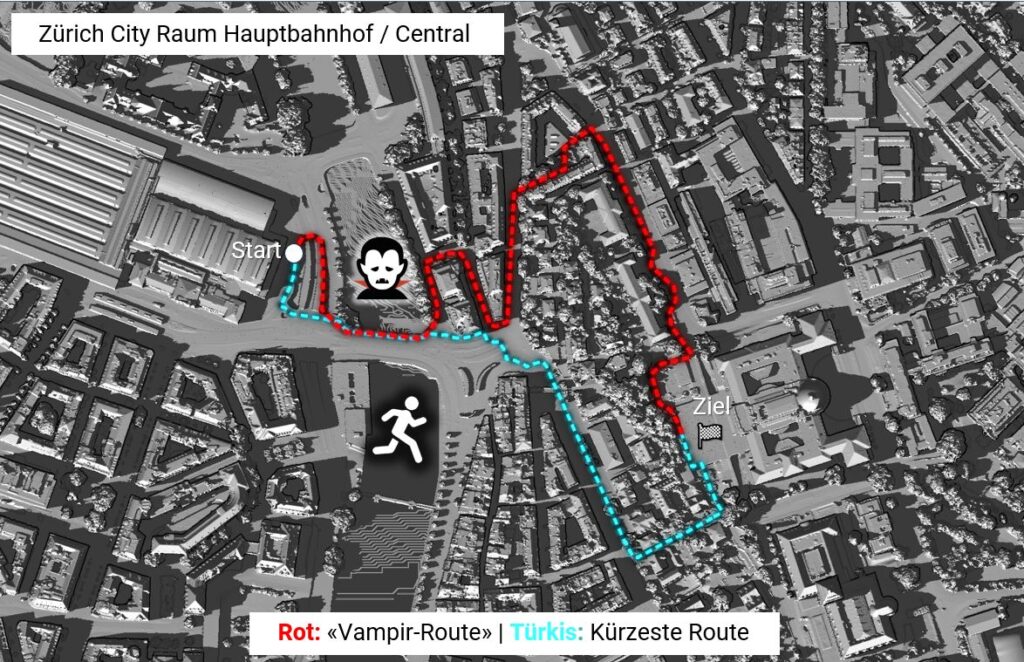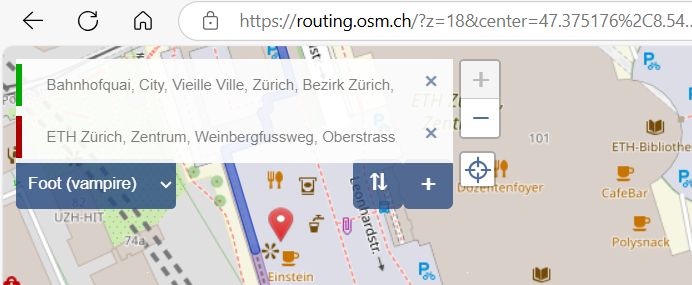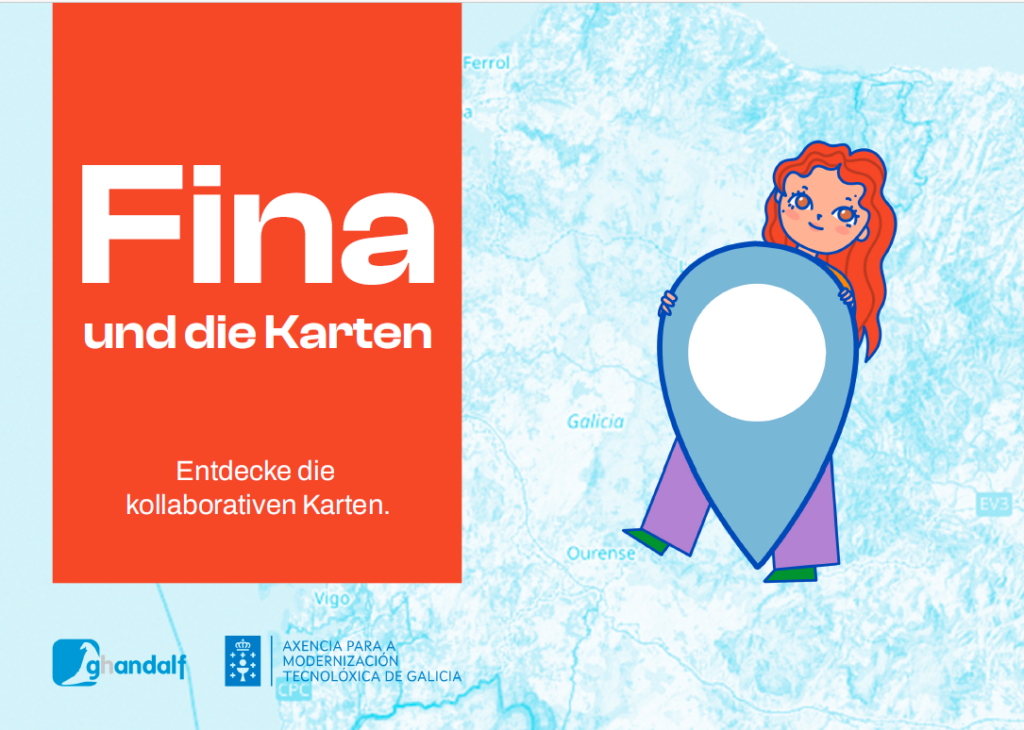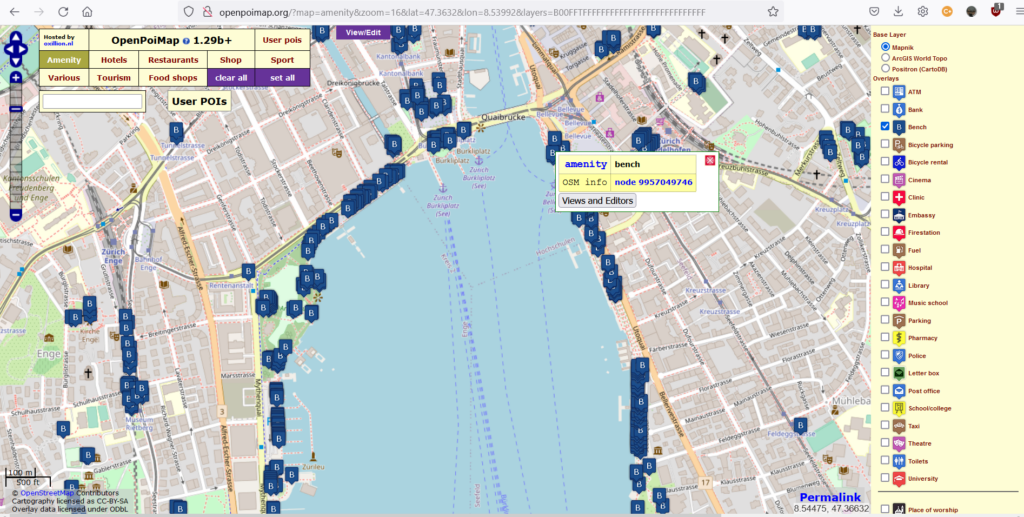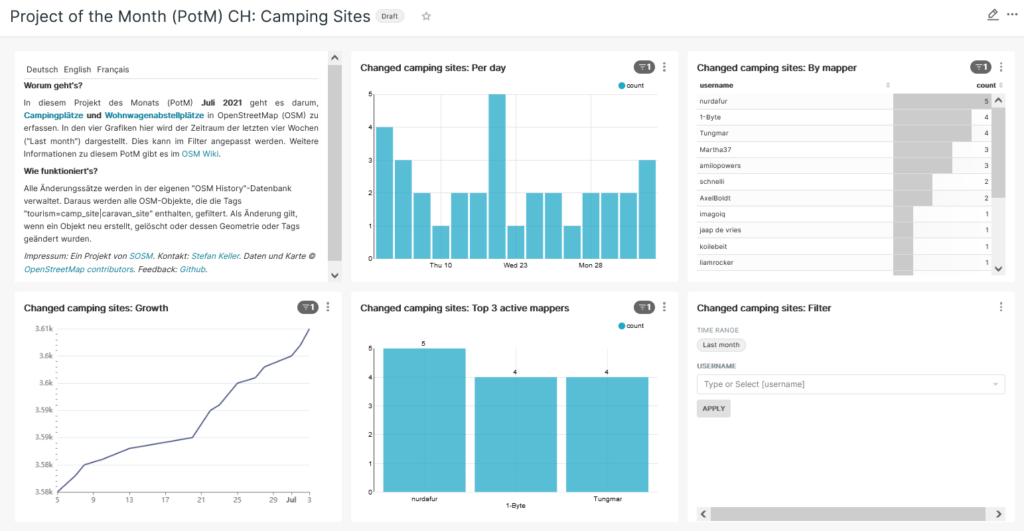Dieses Q&A wird laufend ergänzt und verbessert und kann sich deshalb jederzeit ändern.
Frage: Warum lehnt SOSM den MODI-Gesetzentwurf ab? Ist die Verbesserung der Effizienz unserer Mobilitätsinfrastruktur nicht eine gute Sache?
Antwort: Wir haben uns stets dafür eingesetzt, mehr Mobilitätsdaten verfügbar zu machen, und sind der Ansicht, dass dies ein fehlendes Element für die Schaffung wettbewerbsfähiger, mit Google und Apple konkurrierender Dienste ist. Wir lehnen lediglich eine Regulierung ab, die den Zugriff auf diese Daten an die Nutzung der Navigationsdaten eines einzelnen Marktteilnehmers koppelt.
Frage: Was ist Verkehrsnetz Schweiz und was ist daran problematisch?
Antwort: Verkehrsnetz Schweiz ist das, seit 2019 in Vorbereitung, Konkurrenzprodukt von swisstopo zu bestehenden Angeboten im Navigationsdatenmarkt.
Es handelt sich bei Verkehrsnetz CH um Geodaten, die sich für Navigation und ähnliche Zwecke eignen, genau so wie die Produkte von TomTom, Here, Apple, Google, OpenStreetMap und anderen, die seit Jahrzehnten angeboten werden. Wie jeder dieser Akteure bestätigen wird, ist die Aggregation von Daten aus verschiedenen Quellen, die Durchführung von Qualitätsprüfungen, die Organisation von Updates usw. das A und O der Branche und nicht nur eine Eigenschaft von swisstopos Produkt.
Der Markt für Navigationsdaten ist gesund und bietet eine grosse Auswahl an Wettbewerbern auch wenn Endnutzer vor allem Produkte von google verwenden. Ein weiterer Anbieter mit einem „Me-too“-Produkt ohne zusätzlichen Hebel dürfte weder für die anderen noch für uns ein Problem darstellen.
Wir sind auch etwas geschmeichelt, dass wir offenbar so wichtig sind, dass eines der wichtigsten Merkmale von Verkehrsnetz CH darin besteht, dass es in einem OSM-kompatiblen Format verfügbar sein wird, so dass swisstopo einfacher die Nutzung von OpenStreetMap in bestehenden Anwendungen verdrängen kann.
Realistisch betrachtet ist aber der Markt für ein solches Produkt sehr klein und ohne zusätzliche Massnahmen dürfte es kaum erfolgreich sein. Die rechtliche und technische Kopplung des Zugangs zur Mobilitätsdateninfrastruktur an die Nutzung von Verkehrsnetz Schweiz verändert diese Situation jedoch und wird die Wettbewerbsbedingungen deutlich zugunsten von swisstopo verschieben.
Frage: Können Sie ein Beispiel dafür nennen, warum die Kopplung des MODI-Zugangs an Verkehrsnetz Schweiz den Wettbewerb behindert?
Antwort: Stellen Sie sich folgendes, hypothetisches, Szenario vor: Sie betreiben einen E-Bike-Verleih, dessen Velos über OSM-basierte Navigationssysteme verfügen. Sie möchten die Mobilitätsdaten des Bundes (MODI) nutzen, um die Navigation zu verbessern, z. B. um Sperrungen oder Staus zu vermeiden. Um die entsprechenden Daten abzurufen müssen Sie aber Verkehrsnetz CH brauchen und können nicht einfach die Daten nutzen, die schon so oder so für die Navigation verwenden.
Anders ausgedrückt: Sie müssen entweder zusätzliche Aufwand unternehmen, um die ursprüngliche OSM-Technologie in Ihren Navigationssystemen weiter zu verwenden, zum Beispiel parallel beide Datenbestände vorhalten, oder Sie beziehen einfach Daten von swisstopo in einem OSM-kompatiblen Format und greifen dann reibungslos auf die MODI zu.
Und wenn Sie den Nutzungsstatus Ihrer Velostationen (automatisch) allen zur Verfügung stellen möchten, da multimodale Navigationssysteme dann Nutzer zu einer Station mit freien Velos leiten können, müssen Sie natürlich auch die Daten des Verkehrsnetz CH verwenden, um die Daten in MODI hochzuladen, selbst wenn Sie ansonsten OSM zur Verwaltung Ihrer Standorte verwenden.
Wäre der Zugriff auf die MODI-Daten sowohl technisch als auch rechtlich anbieterneutral gestaltet, würde niemand bevorzugt. So wie in der Vorlage geplant, unabhängig davon, ob wir in Zukunft Workarounds für den MODI-Zugang anbieten oder nicht, wird es immer zusätzliche Reibungspunkte und Unsicherheiten hinsichtlich der korrekten Funktionsweise geben, und die Nutzer werden auf Verkehrsnetz CH umsteigen, weil dessen Funktion „garantiert“ ist.
Frage: Wir sind hier in der Schweiz. Hätten Meinungsverschiedenheiten über den Gesetzentwurf nicht schon vor diesem Stadium geklärt werden müssen?
Antwort: Ja, man hätte erwarten können, dass wir, als eine der wenigen Organisationen, die direkt von der Regulierung betroffen sind, frühzeitig angesprochen worden wären. Wir wurden jedoch nicht nur nicht zur Vernehmlassung eingeladen und mussten, nachdem wir davon erfahren hatten, innerhalb Tagesfrist unsere Stellungnahme einreichen, sondern unsere Bedenken wurden auch von keiner der von uns kontaktierten Stellen je auch nur ansatzweise ernst genommen.
Es muss hier gesagt werden, dass wir einen nicht ganz einfach zu verstehenden technisch-rechtlichen Standpunkt vertreten, dessen Bedeutung vielen möglicherweise entgeht. Ganz zu schweigen davon, dass wir eine kleine Stimme sind im Vergleich zu den vielen swisstopo-Aperos, Beraterhonorare und natürlich nicht zu vergessen, die Aussicht auf Gratisgeld vom Bund,
Frage: Wird Google dadurch nicht eingeschränkt und kleinen Unternehmen mehr Möglichkeiten geboten, Dienstleistungen anzubieten?
Antwort: swisstopo hat bei der Förderung von Verkehrsnetz Schweiz natürlich die „bad Big-Tech“-Karte ausgespielt. Ein Zitat aus ihrem „Faktenblatt Verkehrsnetz CH“:
Kartendienste wie OpenStreetMap oder Google verfügen über umfassende Verkehrsdaten. Diese sind jedoch in jeder Hinsicht nicht frei zugänglich oder sind mit kommerziellen Interessen verbunden, z.B. Beworbene Informationen werden bevorzugt angezeigt. Zudem ist nicht immer transparent, woher die Daten kommen.
Der Verweis auf OpenStreetMap wurde nach unserem Eingreifen entfernt, er verdeutlicht aber sehr schön die herrschende Denkweise.
Natürlich dürften Unternehmen wie Google und Apple davon überhaupt nicht betroffen sein, da sie keinen direkten Zugang zu Navigationsdaten bieten und, falls sie die MODI-Daten zusätzlich zu ihren bereits vorhandenen überhaupt nutzen wollen, diese hinter ihren APIs verbergen können und wahrscheinlich sogar Kosten sparen werden im Vergleich zum jetzigen Zustand.
Ein Blick über die Grenze nach Österreich, wo vor über einem Jahrzehnt ein ähnliches Projekt gesetzlich verankert wurde, zeigt zwar keine geringere Nutzung von Google, aber einen deutlichen Mangel an Produkten, die Mitbewerber nutzen. Stattdessen besteht ein De-facto-Monopol für bestimmte Sektoren, dass auf dem GIP (entspricht dem Verkehrsnetz CH) und der VAO (dem halbprivaten MODI-Äquivalent) basiert. Die VAO-Dienste sind nicht kostenlos, und soweit von aussen feststellbar ist, werden die Preise nach belieben festgesetzt, ein klassisches Monopolmerkmal. Dies ist auch das längerfristige MODI-Szenario.
Frage: Wo finde ich den Gesetzestext und die dazugehörigen Materialien?
Antwort: Unterlagen des Bundesrates zur Vorlage
Frage: Ist das nicht alles Open Data und deshalb kein Problem?
Antwort: Viele Teile von Verkehrsnetz CH und MODI werden voraussichtlich als Open Data verfügbar sein. Neben Unklarheiten ob die Bedingungen dann auch tatsächlich die Nutzung in OSM erlauben werden, gibt es vermutlich Ausnahmen mit Bedingungen die im OSM-Kontext nicht erfüllt werden könnten. Siehe fossgis.de Stellungnahme zum Mobilitätsdatengesetz für ein ähnliches Problem mit der deutschen Regulierung.
Wichtiger ist, dass Open Data zwar Innovationen fördern und mehr Wirtschaftstätigkeit schaffen kann, dies aber voraussetzt, dass ein veröffentlichendes Unternehmen den Markt nicht mit seinen eigenen Produkten monopolisiert und entsprechenden Freiraum lässt. Wie swisstopo zeigt, besteht der Haupteffekt der Veröffentlichung ihrer Daten zu offenen Bedingungen seit März 2021 darin, dass das Unternehmen deutlich weniger Druck hat, seine Angebote wirtschaftlich zu rechtfertigen und selbst mehr Felder besetzen kann. „Es sind offene Daten“ ist buchstäblich zur universellen Ausrede für alle Aktivitäten geworden.
Wie bereits erwähnt, besteht die Hoffnung, dass wir die dann veröffentlichten Daten nutzen können, um eine MODI kompatible OSM-Datenverteilung zu produzieren, falls der Gesetzgeber, wie erwartet, beschliesst, keinen anbieterneutralen Zugang vorzuschreiben. Dies wäre jedoch naturgemäss eine zweitklassige und mit hohen Reibungsverlusten verbundene Lösung. Weiter ist es auch unklar inwiefern App- und Dienstentwickler überhaupt Unterstützung für eine schweizerische Sonderlösung einbauen würden. Dies gilt natürlich auch generell auch für die direkte Unterstützung fur MODI ohne OSM..
Es sollte eigentlich keine Rolle spielen, ob Sie Ihre App oder Ihren Dienst mit Daten und Diensten von TomTom, Here, Google, Apple, OSM oder Swisstopo entwickeln. Die Technologie ist vorhanden, um MODI anbieterunabhängig zu machen. Was fehlt, ist der politische Wille, dies auch zu fordern.
Frage: Was sind die konkreten Forderungen von SOSM?
Antwort: die SOSM fordert, dass die MODI-Komponenten Verkehrsnetz CH und NADIM entkoppelt werden und dass der Gesetzentwurf einen Geodatenanbieter-unabhängigen Zugang zu NADIM vorschreibt. Wir schlagen ausserdem vor, die Einrichtung von Verkehrsnetz CH in einen separaten Gesetzentwurf zu verschieben, um eine unabhängige Bewertung und Entscheidung über das Vorhaben zu ermöglichen.
Frage: Verlangt der Gesetzentwurf nicht, dass das MODI von Marktakteuren unabhängig ist?
Antwort: Art. 6 lit. a des MODI-Gesetzentwurfs besagt: „Das MODI ist von den Marktakteuren unabhängig.“ Dabei wird jedoch völlig ignoriert, dass swisstopo nach jeder Definition, auch nach ihrer eigenen, ein solcher Marktteilnehmer ist. swisstopo positioniert sich nicht nur in ihren Werbematerialien für Verkehrsnetz CH als Konkurrent anderer Kartendienstleister, sondern bietet auch Kartendienste für Webentwickler und Produkte für Endnutzer im Wettbewerb mit anderen Marktteilnehmern an. Siehe beispielsweise Swisstopo App

